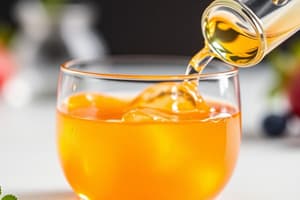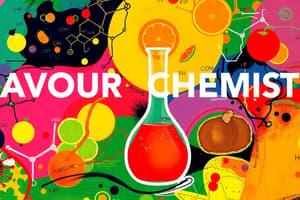Podcast
Questions and Answers
Which of the following best describes flavour?
Which of the following best describes flavour?
- A combination of taste and odor. (correct)
- A property detected only by the olfactory system.
- Something related only to the taste buds.
- Only refers to the appearance of food.
Taste substances are generally volatile and oily.
Taste substances are generally volatile and oily.
False (B)
List the four primary taste sensations.
List the four primary taste sensations.
Sweet, Salty, Sour, Bitter
Flavour is composed of taste and __________.
Flavour is composed of taste and __________.
Match the following components with their definitions:
Match the following components with their definitions:
What is the primary characteristic component of pungency found in spices such as ginger and chili?
What is the primary characteristic component of pungency found in spices such as ginger and chili?
When cabbage is cooked, isothiocyanates are formed due to the activity of the enzyme myrosinase.
When cabbage is cooked, isothiocyanates are formed due to the activity of the enzyme myrosinase.
What happens when lemon juice is added to a mixture?
What happens when lemon juice is added to a mixture?
The pungent component of mustard oil produced from glucosinolates is known as __________.
The pungent component of mustard oil produced from glucosinolates is known as __________.
Match the following sensations or substances with their descriptions:
Match the following sensations or substances with their descriptions:
Which of the following artificial sweeteners is known to be 300 times sweeter than sucrose?
Which of the following artificial sweeteners is known to be 300 times sweeter than sucrose?
Sodium cyclamate is currently allowed for use in the USA.
Sodium cyclamate is currently allowed for use in the USA.
What is the main characteristic of sugars that defines sweetness?
What is the main characteristic of sugars that defines sweetness?
Isomalt is a sugar alcohol made by a _______ that is less sweet than sucrose.
Isomalt is a sugar alcohol made by a _______ that is less sweet than sucrose.
What is one disadvantage of using saccharin as a sweetener?
What is one disadvantage of using saccharin as a sweetener?
Match each sweetener to its property:
Match each sweetener to its property:
Sugar alcohols contribute significantly to caloric intake.
Sugar alcohols contribute significantly to caloric intake.
Which of the following sweeteners is known for its clean sucrose-like flavor?
Which of the following sweeteners is known for its clean sucrose-like flavor?
Sweetness has received the most attention from research due to its special characteristic of _______.
Sweetness has received the most attention from research due to its special characteristic of _______.
Sucralose is unstable at high temperatures.
Sucralose is unstable at high temperatures.
What is the main health concern associated with aspartame for certain individuals?
What is the main health concern associated with aspartame for certain individuals?
Neohesperidine Dihydrochalcone is ____ to ____ times sweeter than sucrose.
Neohesperidine Dihydrochalcone is ____ to ____ times sweeter than sucrose.
Match the following sweeteners with their sweetness relative to sucrose:
Match the following sweeteners with their sweetness relative to sucrose:
Which sweetener is derived from the liquorice root?
Which sweetener is derived from the liquorice root?
Alitame promotes Maillard browning.
Alitame promotes Maillard browning.
What makes Neohesperidine Dihydrochalcone (DHC) particularly useful in pharmaceutical products?
What makes Neohesperidine Dihydrochalcone (DHC) particularly useful in pharmaceutical products?
Which substance is known as the best cooling agent?
Which substance is known as the best cooling agent?
The additions of MSG to foods that naturally contain IMP has no effect on the flavor.
The additions of MSG to foods that naturally contain IMP has no effect on the flavor.
What are the two main components that contribute to the umami taste in meat?
What are the two main components that contribute to the umami taste in meat?
IMP is a breakdown product of __________ that accumulates as ATP is utilized in the muscle.
IMP is a breakdown product of __________ that accumulates as ATP is utilized in the muscle.
Match the following compounds to their role in meat flavor:
Match the following compounds to their role in meat flavor:
When combined, a mixture of IMP and MSG tastes how many times stronger than either alone?
When combined, a mixture of IMP and MSG tastes how many times stronger than either alone?
Aged meat typically has a lower flavor due to less protein breakdown.
Aged meat typically has a lower flavor due to less protein breakdown.
Which group of compounds contributes to the flavor of meat alongside MSG and IMP?
Which group of compounds contributes to the flavor of meat alongside MSG and IMP?
What is the sweetness intensity of thaumatin compared to sucrose?
What is the sweetness intensity of thaumatin compared to sucrose?
The taste of sodium chloride is categorized as bitter.
The taste of sodium chloride is categorized as bitter.
What property distinguishes salty taste from bitter taste according to ionic diameter?
What property distinguishes salty taste from bitter taste according to ionic diameter?
Naringin is a phenolic substance found in ______.
Naringin is a phenolic substance found in ______.
Match the following acids with their sources:
Match the following acids with their sources:
Which of the following compounds is used as a bittering agent in soft drinks?
Which of the following compounds is used as a bittering agent in soft drinks?
Bitterness is considered undesirable in beer.
Bitterness is considered undesirable in beer.
What is the primary role of Na ions in food flavor?
What is the primary role of Na ions in food flavor?
Astringency results from reactions of proteins in saliva with ______.
Astringency results from reactions of proteins in saliva with ______.
Which ion has a diameter that is below that of potassium bromide, resulting in a predominantly salty taste?
Which ion has a diameter that is below that of potassium bromide, resulting in a predominantly salty taste?
Flashcards
Flavor
Flavor
The combination of taste and odor perceived by our senses.
Taste
Taste
The property of liquids, solids, or gases in solution that is detected by taste buds.
Odor
Odor
The property of volatile substances detected by the olfactory system. We smell it.
Challenges in Flavor Research
Challenges in Flavor Research
Signup and view all the flashcards
Complex Flavor Mixtures
Complex Flavor Mixtures
Signup and view all the flashcards
Umami
Umami
Signup and view all the flashcards
Sweetness
Sweetness
Signup and view all the flashcards
Sugar Alcohols
Sugar Alcohols
Signup and view all the flashcards
Artificial Non-sugar Sweeteners
Artificial Non-sugar Sweeteners
Signup and view all the flashcards
Saccharin
Saccharin
Signup and view all the flashcards
Sodium Cyclamate
Sodium Cyclamate
Signup and view all the flashcards
Acesulfame K
Acesulfame K
Signup and view all the flashcards
Aspartame
Aspartame
Signup and view all the flashcards
Stevioside (Stevia)
Stevioside (Stevia)
Signup and view all the flashcards
Glycyrrhizin
Glycyrrhizin
Signup and view all the flashcards
Sucralose
Sucralose
Signup and view all the flashcards
Neohesperidine Dihydrochalcone (DHC)
Neohesperidine Dihydrochalcone (DHC)
Signup and view all the flashcards
Alitame
Alitame
Signup and view all the flashcards
Neohesperidine Dihydrochalcone (DHC)
Neohesperidine Dihydrochalcone (DHC)
Signup and view all the flashcards
Sucralose
Sucralose
Signup and view all the flashcards
Pungency
Pungency
Signup and view all the flashcards
Capsaicinoids
Capsaicinoids
Signup and view all the flashcards
Glucosinolates
Glucosinolates
Signup and view all the flashcards
Myrosinase
Myrosinase
Signup and view all the flashcards
Isothiocyanates
Isothiocyanates
Signup and view all the flashcards
What is Umami?
What is Umami?
Signup and view all the flashcards
What is MSG?
What is MSG?
Signup and view all the flashcards
What is IMP?
What is IMP?
Signup and view all the flashcards
What is the synergistic effect of IMP and MSG?
What is the synergistic effect of IMP and MSG?
Signup and view all the flashcards
What is odor?
What is odor?
Signup and view all the flashcards
What are dipeptides?
What are dipeptides?
Signup and view all the flashcards
What are the main components of meat flavor?
What are the main components of meat flavor?
Signup and view all the flashcards
What are the challenges of flavor research?
What are the challenges of flavor research?
Signup and view all the flashcards
Thaumatin
Thaumatin
Signup and view all the flashcards
Saltiness vs. Bitterness: Size Matters
Saltiness vs. Bitterness: Size Matters
Signup and view all the flashcards
Citrus Bitterness & Flavonoids
Citrus Bitterness & Flavonoids
Signup and view all the flashcards
Bitterness: Protection from Poisons
Bitterness: Protection from Poisons
Signup and view all the flashcards
Saltiness: The Tongue's Side Story
Saltiness: The Tongue's Side Story
Signup and view all the flashcards
Sodium Ions & Food Flavor
Sodium Ions & Food Flavor
Signup and view all the flashcards
Sourness: More Than Just H+ Ions
Sourness: More Than Just H+ Ions
Signup and view all the flashcards
Astringency: A Mouth-Feel
Astringency: A Mouth-Feel
Signup and view all the flashcards
Tannins: Astringent & Anti-Nutritional
Tannins: Astringent & Anti-Nutritional
Signup and view all the flashcards
Moderating Black Tea Astringency
Moderating Black Tea Astringency
Signup and view all the flashcards
Study Notes
Flavour Chemistry
- Nutritionists often overlook that flavour, not nutrients, is the main driver of appreciation at mealtimes.
- Flavour combines taste and odor.
- Taste is perceived by dissolved chemicals stimulating cells in taste buds.
- Odor is detected by volatile chemicals stimulating receptors in the olfactory system.
Difficulties in Flavour Investigation
- There's no standard test for detecting flavor.
- Food flavour is seldom caused by one substance alone.
- Recreating complex flavours is challenging due to the interplay of various components, even in small amounts.
Taste
- Taste substances are typically water-soluble and non-volatile.
- Four primary taste sensations are sweet, salty, sour, and bitter.
- Umami is a fifth taste, described as savory or meaty.
Sweetness
- Sweetness is a significant area of research, especially regarding sugars.
- Sucrose is the reference standard for sweetness measurement.
- Relative sweetness of different sugars varies.
- Sugar alcohols are derived from their parent sugars by reducing the carbonyl group to a hydroxyl group.
- Isomalt is an example of a sugar alcohol.
- Unabsorbed by the small intestines, these contribute minimally to caloric intake.
- Excessive consumption can lead to osmotic diarrhea.
Artificial Non-Sugar Sweeteners
- Various artificial sweeteners differ in their relative sweetness (compared to sucrose).
- Each sweetener has individual advantages (like low calories, stability) and disadvantages (aftertaste or concerns about safety in certain contexts).
Other Sweeteners
- Sucralose (Splenda): A chlorinated sucrose derivative, highly stable and long-lasting.
- Alitame: Extremely sweet, derived from amino acids and promoting Maillard browning reactions.
- Saccharin, Sodium Cyclamate, Acesulfame-K: All synthetic sweeteners with different sweetness intensities and characteristics.
Other Flavouring Descriptors
- Bitterness: The perceived flavour of metal halides, related to the size of the ion. Phenolic compounds in fruit juices (Naringin, Limonin) can be bitter, and are important sources of bitterness. Bitterness is also desirable in beverages like beer. Bitterness is a sign of some harmful organic compounds in plants.
- Saltiness: Perceived by inorganic salts like sodium chloride. Affecting flavour, but not an essential taste.
- Sourness: Associated with acidic solutions, dominated by organic acids in food.
- Astringency: A dry feeling in the mouth, caused by polyphenolic compounds interacting with proteins. Found in red wine and tea.
- Pungency: A hot sensation, mostly from capsaicinoids in chili peppers.
- Cooling: A sensation associated primarily with menthol or similar substances, found in some foods like mint.
- Meatiness/Umami: Caused by a combination of glutamic acid (MSG) and inosine monophosphate (IMP). Commonly present in meat.
- Odor: While often ignored, odor greatly influences our perceptions of food.
- Fruit Flavor: A complex combination of taste and odors. The specific constituents contributing to the flavor vary between types of fruit.
- Vegetable Flavor: Often determined by the enzyme lipoxygenase, which reacts with unsaturated fatty acids in damaged vegetable cells.
- Onion and Garlic Flavor: The pungent flavor is caused by specific chemical compounds produced when onion and garlic are crushed or sliced. Allicin, present in garlic, has potent antimicrobial, antithrombotic, and anticancerogenic properties.
Synthetic Flavorings
- More demanded in recent years, with an emphasis on high-quality chocolate flavorings.
- Specific compounds in certain foods are identified and synthesized to produce specific tastes.
- Often associated with distinct flavor compounds which are isolated and synthesized to match natural flavors.
Studying That Suits You
Use AI to generate personalized quizzes and flashcards to suit your learning preferences.




